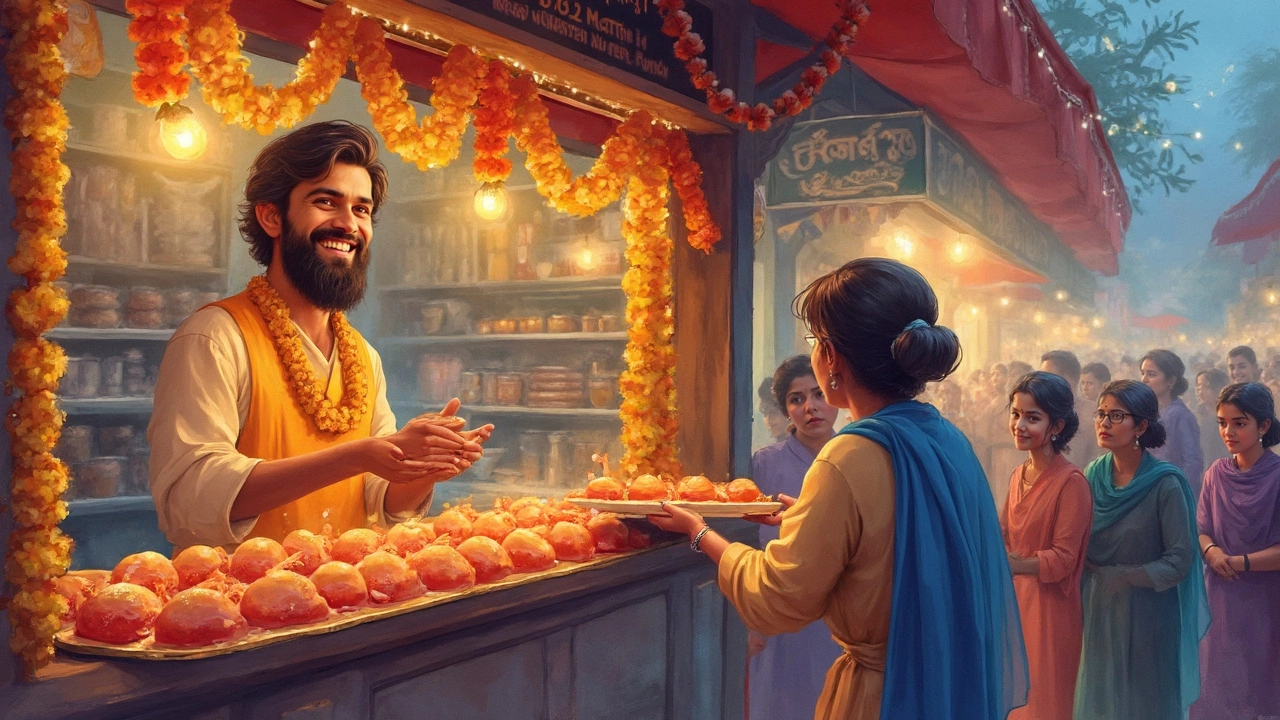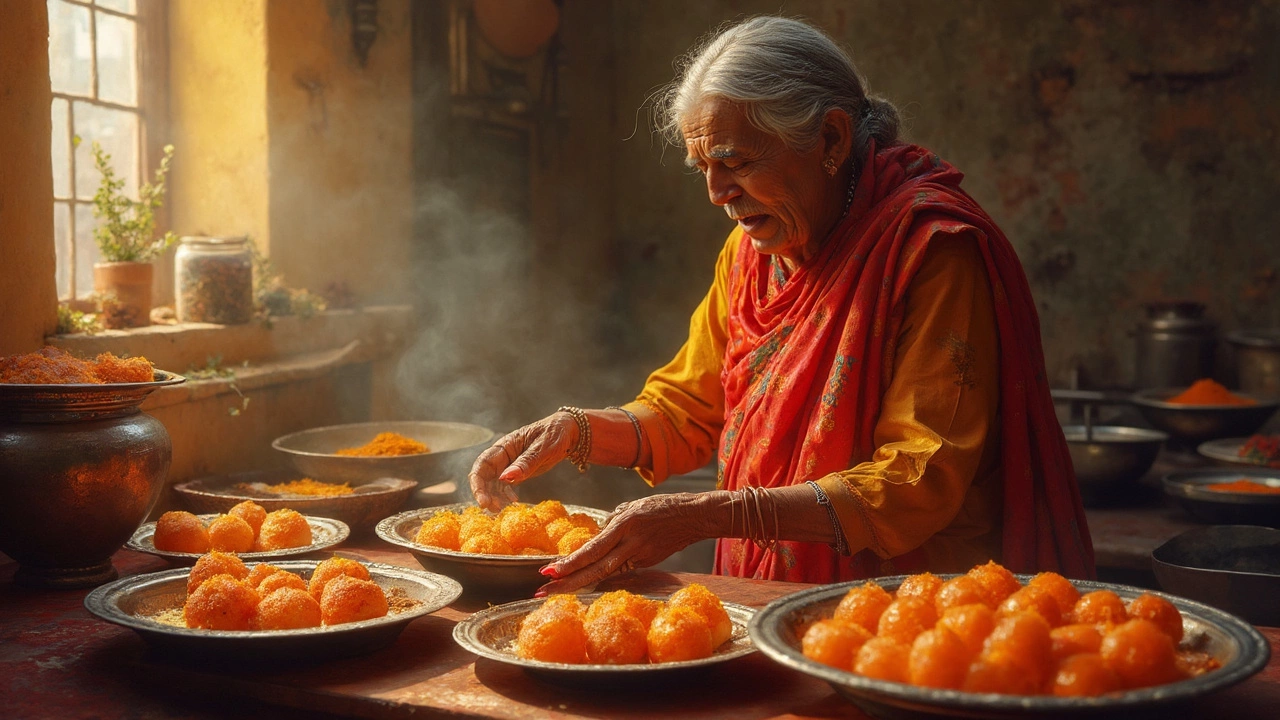When it comes to sweets in India, let's talk about one that frequently takes the limelight: Gulab Jamun. This dessert isn't just a treat; it's an emotion for many, often making its way to celebrations and festivals.
Gulab Jamun is a decadent sweet made primarily from milk solids, deep-fried to a golden crisp and then soaked in fragrant sugar syrup. But what makes it the darling of Indian desserts?
The magic lies in its simplicity and the perfect balance of flavors. The milk solids, typically from khoya or milk powder, give it a rich texture, while cardamom and saffron in the syrup add an aromatic lift.
Aside from its basic form, Gulab Jamun has many avatars across India. From stuffed versions to those spiked with hints of rosiness, each brings a unique twist while staying true to the essence.
- Introduction to Indian Sweets
- The Reign of Gulab Jamun
- Tips for Making Perfect Gulab Jamun
- Regional Variations and Other Contenders
Introduction to Indian Sweets
Dive into the sugar-spun world of Indian sweets, and you'll find a variety that can easily dazzle any dessert lover. Known locally as 'mithai', these treats are a blend of cultural heritage and culinary mastery.
India's landscape of sweets is as vast and diverse as the country itself. Each region boasts its specialities, often inspired by local ingredients. Northern Indian states might beckon you with Jalebis and Rasmalai, while southern parts are famed for Mysore Pak and Payasam.
What's so captivating about Indian cuisine dessert choices is the storytelling behind each sweet. Traditional recipes often weave in anecdotes of family legacies. It's not just about taste; it's about experiencing history.
A Delicious Variety
Indian sweets encompass everything from simple to sophisticated. Milk-based desserts like Gulab Jamun and Kheer stand shoulder to shoulder with flour-based ones like Besan Ladoo, showing off the diversity beautifully.
- Gulab Jamun: Remember, this is the superstar of desserts! Made from khoya, deep-fried, and soaked in sugary syrup, it's a must-try.
- Rasgulla: Hailing from Bengal and Odisha, these sponge-like balls in syrup are a delight, emphasizing the beauty of simplicity.
- Jalebi: Known for its spirals and crunchiness, this sweet is a staple during festivals.
Though many of these sweets have ancient roots, today they often get innovative twists. Even something timeless like Gulab Jamun is being reimagined with flavors like rose or saffron, and new desserts incorporating Indian flavors are emerging in global culinary scenes.
The Reign of Gulab Jamun
It's quite fascinating how Gulab Jamun has become the sweetheart of Indian sweets, but what's the backstory? This tender, syrupy delight wasn't originally from India. It is believed to have originated from Iran, finding its way to Indian kitchens during the Mughal era. The blend of flavors and textures captured hearts and taste buds alike.
What Makes Gulab Jamun So Popular?
In the sprawling world of Indian cuisine, this humble dish stands out for a few reasons. First, there's the unforgettable hit of cardamom and rose water perfuming the syrup - it's like a waterfall of flavors with every bite. Then there's the texture. A perfect Gulab Jamun should be soft and spongy, not doughy or heavy.
The beauty of these sweets is in how they absorb flavors. Frying gives them a light crust, and the soaking ensures they’re brimming with sweet goodness throughout. With these qualities, they've cemented their spot as a must-have for weddings, festivals, and family gatherings.
Gulab Jamun on Every Occasion
Wherever there's a celebration, there's a high chance you'll find a Gulab Jamun in the mix. During Diwali, they're presented in decorative boxes as gifts. Holi parties? Yep, they often make an appearance alongside the vibrant colors. Even in everyday life, a plate of Gulab Jamun is enough to brighten someone’s mood after a hard day.
Fun Facts
- The name 'Gulab Jamun' comes from the Persian words 'Gol' (flower) and 'Āb' (water), referring to the rose-scented syrup. 'Jamun' is the South Asian term for Black Plum due to the dessert's shape and size.
- Every year, the sweet sees creative twists; from mini versions ideal for parties to fusion desserts like Gulab Jamun cheesecakes.
Gulab Jamun's luscious legacy continues to grow, blending taste and tradition, making it a king among dessert recipes.

Tips for Making Perfect Gulab Jamun
Wanna nail that Gulab Jamun recipe? It's all about the details, and here's how you can turn your kitchen into a dessert haven.
Choose the Right Ingredients
The key to a top-notch Gulab Jamun is using quality ingredients. Start with fresh khoya or a good brand of milk powder. If you prefer the latter, mix it with a little cream for that rich texture.
Prepare the Dough Correctly
- Mix the khoya or milk powder with a small amount of all-purpose flour and baking soda. The flour acts as a binder, while baking soda gives the jamuns a soft interior.
- Add water or milk gradually, aiming for a smooth dough that's soft but not sticky.
- Rest the dough for at least 10 minutes. It helps the gluten relax.
The Art of Frying
Frying plays a big role. Use a deep pan with oil at the right temperature. Too hot, and the jamuns will brown quickly but stay raw inside; too cold, and they'll soak up too much oil. Aim for medium heat.
- Test by dropping a small piece of dough; it should rise slowly to the surface.
- Keep the batch small. Fry a few balls at a time and keep them constantly moving for even cooking.
Perfecting the Sugar Syrup
The syrup should be just right—not too thick, not too runny. Mix sugar and water in a pan and let it dissolve completely over medium heat. Add cardamom pods or saffron strands for aroma and flavor.
- Add a teaspoon of rose water after removing from heat to enhance aroma.
- Ensure the syrup is warm—not hot—when you add the fried jamuns. They need to soak it in without losing shape.
| Ingredient | Quantity |
|---|---|
| Khoya | 250g |
| All-Purpose Flour | 2 tbsp |
| Sugar | 1 cup |
| Water | 1 1/2 cups |
Follow these steps, and you'll have a batch of soft and rich Gulab Jamun to impress just about anyone. Happy cooking!
Regional Variations and Other Contenders
It's fascinating how Indian sweets showcase a tapestry of flavors reflecting the country's diverse culture, and this is vividly seen in how Gulab Jamun is prepared from one region to another. Let's explore some of these exciting regional takes and also peek into other popular desserts vying for the top spot.
Regional Gulab Jamun Variations
In different parts of India, Gulab Jamun gets a special twist. If you head over to eastern India, particularly Bengal, you might find Pantua, a similar dessert but with a caramel-colored, slightly thicker syrup. Each bite tells a different story with its more intense sweetness.
In some North Indian states, there's Kala Jamun—darker in color and firmer in texture. It's made with additives like paneer or paneer mixed with khoya, and the syrup sometimes carries hints of rose or cardamom.
Then there's the South Indian variant, where they use rice flour blends or even use coconut as part of the filling. The slight crunch from this adds an unexpected texture that makes it memorable.
Other Popular Sweet Contenders
As much as we adore Gulab Jamun, the sweet scene in India is fiercely competitive. Let's not forget the divine dessert recipes like Rasgulla from Odisha and Bengal. Its spongy, syrup-drenched balls have held their own in sweet conversations around the country.
Ladoo, another classic, is versatile—from the besan (gram flour) ladoos exchanged during Diwali to the boondi ladoos from the temples of North India. They're cultural icons, each variant having its roots in ritual and festivity.
And who can ignore Jalebi? This crispy, syrupy delight spirals its way into both rural and urban hearts alike. Its fiery orange hue and chewy texture offer an irresistible contrast that's hard to pass up.
Popularity by Region: A Sweet Table
| Region | Popular Sweet |
|---|---|
| North India | Sohan Halwa |
| South India | Mysore Pak |
| West India | Modak |
| East India | Pithe |
There’s no denying the sweetness that fills the air throughout India, with each region offering its own unique spin on what sweetness should be. Whether it’s the milky richness of Gulab Jamun or the various other sweet treats, India’s dessert culture is as varied as it is delicious.
